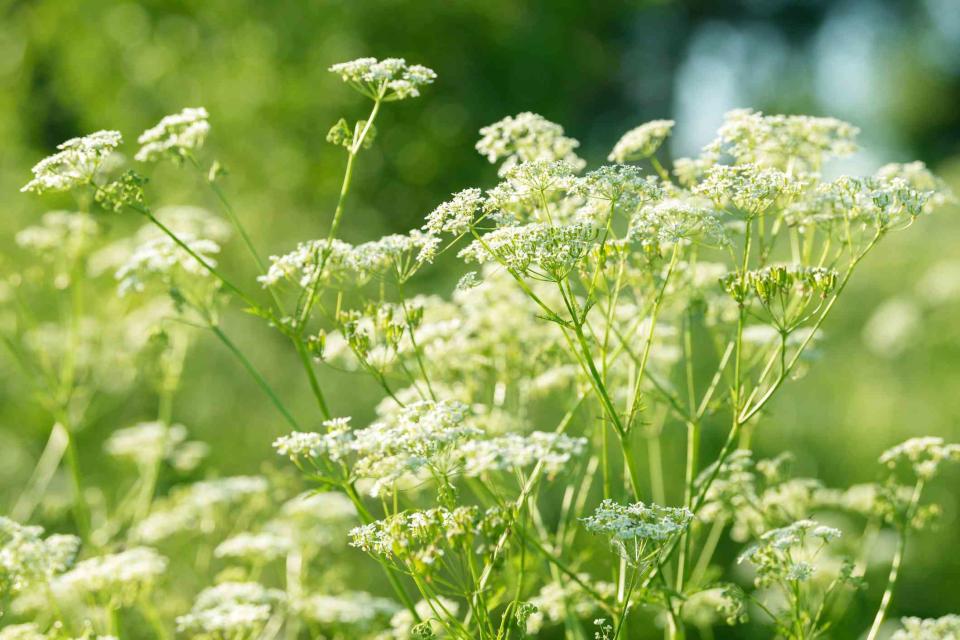How to Plant and Grow Anise
Grow your own anise plants to add a sweet licorice flavor to breads, cakes, cookies, and beverages.

Cyrustr / Getty Images
Anise is one of the oldest culinary herbs. Native to the Middle East, this annual plant is known for its seeds that provide a spicy, sweet licorice flavor to bread, cakes, cookies, and beverages. It’s often confused with star or Chinese anise (Illicium verum), an evergreen shrub with seedpods that taste similar to anise. You can also use anise leaves to sprinkle on salads or as a garnish. The lower leaves are heart-shaped, and the upper leaves resemble those of a dill plant. Each plant produces compound flower clusters, or umbels, of many tiny white flowers. These flowers later produce the small, grayish-brown seeds that are harvested for their sweet flavor.
Where to Plant Anise
Plant anise seed in a sunny, sheltered area of the garden that’s out of the wind. This herb tends to have weak stems, so may need staking if conditions get breezy. Anise can be a bit finicky since it's usually very sensitive to baking sun and cold northern winds so it may take some trial and error to find the perfect spot in your garden for it.
You can also plant anise in containers right outside your back door for a sweet licorice scent within steps of the kitchen. It grows well with coriander, so try creating a colorful group of containers stocked with anise and other herbs with similar needs to turn your patio or balcony into a haven of flavor.
How and When to Plant Anise
Anise is sensitive to cold temperatures. In warm climates with a long growing season, plant anise outside after the last spring frost and once the soil has warmed up. In colder climates with a shorter growing season, sow anise seeds indoors in biodegradable pots about eight weeks before transplanting the seedlings outdoors after all danger of frost has passed. Anise seeds take their time germinating. In fact, It may take up to four weeks until the first seedlings emerge from the soil.
:
Anise Care Tips
Light
Anise grows best in full sun. Try to plant anise where it will get at least 6 hours of direct sunlight a day.
Soil and Water
Plant anise in loamy, well-drained soil. If your soil is very heavy, mix in several inches of compost to give the plants the light-textured soil they prefer. Water anise when the ground starts to dry out, but do not overwater it.
Fertilizing
Add a layer of compost around your anise plants to help provide nutrients through the growing season. You can also provide your plants a dose of all-purpose fertilizer around midsummer.
Harvesting
The seeds will need the entire summer to develop, but you can get a taste of the plant’s licorice flavor by harvesting the leaves throughout the summer. The seedpods will ripen in August and September; you can harvest the seeds as soon as the stalks are dry.
:
Pests and Problems
The willow-carrot aphid is anise’s primary pest. The easiest way to control aphids is to spray them off your plants with a strong stream of water from the garden hose. Aphids are such small, soft-bodied insects that even a good rainstorm can knock them off. Once aphids are knocked off a plant, they rarely climb back on.
However, anise is also susceptible to powdery mildew, so avoid splashing water onto the leaves as much as possible. Water your plants (and wash off pests) in the morning so any moisture on the leaves will dry faster than if you water at night when temperatures start dropping.
Frequently Asked Questions
Does anise come back every year?
<p>Anise is a warm-season annual herb that grows from spring into fall. It will not come back after the winter unless it managed to self-sow a few seeds in the same spot.</p>
How long does it take anise to grow?
<p>It may take up to four weeks until the first seedlings emerge from the soil.<strong> </strong>It takes a warm growing season of at least 120 days for anise to set fruit. You will be able to gather one to two tablespoons of seeds per plant. <br/></p>
Can I grow anise indoors?
<p>As long as you provide anise the warmth, light, and moisture it requires, it will grow indoors in a container. However, it may not bloom as much, and without pollinators like honey bees around, it may not set many seeds<span class="ql-inline-citation" data-cite="1"></span>.</p>

